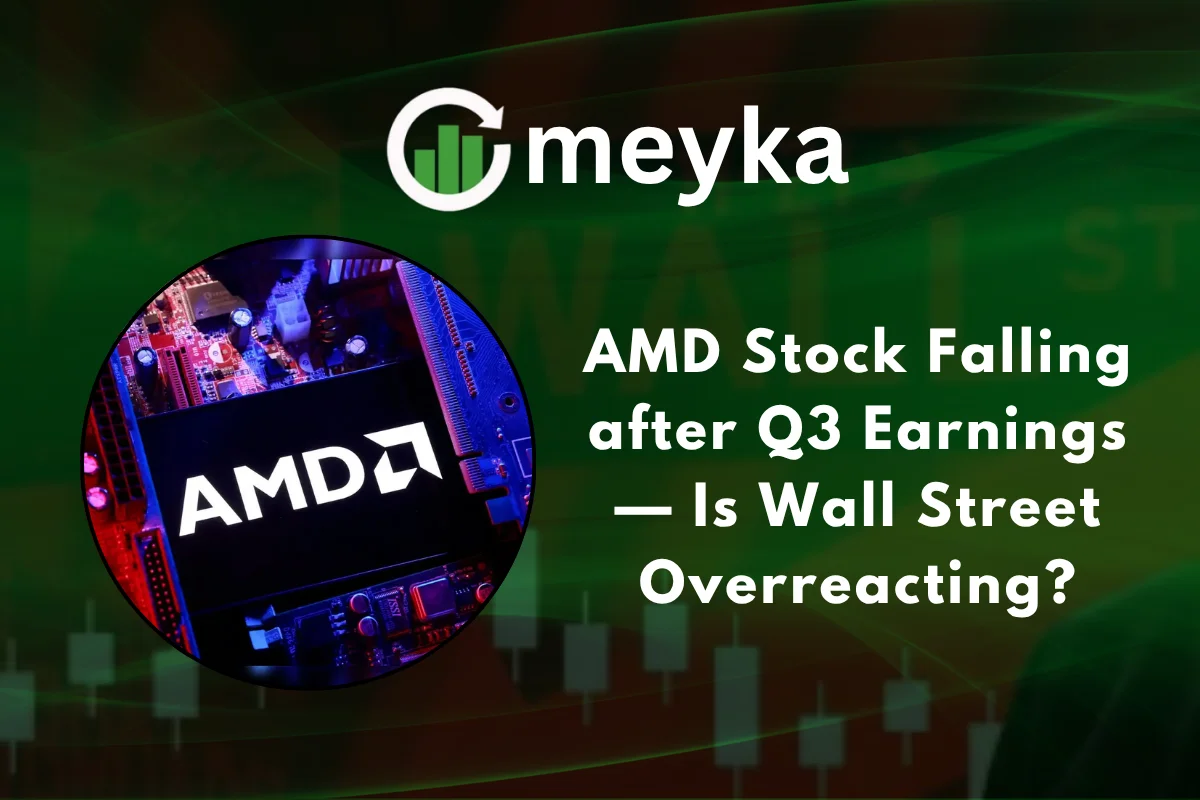AMD Stock Falling after Q3 Earnings — Is Wall Street Overreacting?
The semiconductor industry continues to face volatility, and AMD stock has now become the latest example. After reporting its Q3 2025 earnings, shares of Advanced Micro Devices fell nearly 4% in after-hours trading, even though the company actually beat Wall Street expectations.
This unusual market reaction has raised a key question among investors and analysts: Did the sell-off reflect real business concerns, or is Wall Street simply overreacting?
A Strong Quarter Overshadowed by Market Reaction
AMD reported third-quarter revenue of around $9.2 billion, which marked growth of roughly 36% year-over-year. Earnings per share came in at approximately $1.20 on a non-GAAP basis, exceeding forecasts from industry analysts.
Much of this performance was driven by the company’s data-center division, which benefited from rising demand for server computing and AI acceleration hardware. The gaming and PC-client segments also recorded meaningful growth, signaling that AMD’s product portfolio continues to find strong demand in both consumer and enterprise markets.
However, despite delivering these solid results, the market’s reaction was negative. The biggest reason was not the quarter itself, but the company’s outlook for the next few quarters.
Investors appeared more concerned about AMD’s guidance than impressed by the numbers it reported. In sectors tied closely to high-growth themes such as artificial intelligence, beating earnings is not always enough; the market expects aggressive momentum and future visibility.
Why the Stock Declined Despite Impressive Results
There are several reasons the pullback happened, and none of them indicate that AMD had a “bad” quarter. First, the company’s forward guidance did not exceed expectations to the level analysts anticipated. Investors had priced in very strong future demand, especially in the AI and server-chip segment. When the outlook was solid but not spectacular, some traders saw it as an excuse to sell.
Another factor is the recent rally in semiconductor shares. AMD had already gained significantly in previous weeks as investors rushed into AI-related hardware companies. After a strong run-up, even good news can trigger profit-taking. Large funds sometimes sell into strength simply to secure earnings before uncertainty returns.
Broader macro concerns also play a role. Semiconductor companies still face supply-chain risks, regulatory pressure, and competition from powerful rivals such as NVIDIA and Intel. When expectations are high, even small uncertainties can shake investor confidence.
What It Means for Investors Watching AI and Semiconductor Stocks
For investors doing stock research, AMD’s situation is a reminder of how emotional the stock market can be. Financial performance alone does not determine short-term share price direction. Market psychology, valuation pressure, analyst expectations, and sector momentum all play big roles.
AMD is still deeply positioned in one of the most promising trends in technology: high-performance computing and AI acceleration. The company is supplying chips for cloud data centers, machine-learning systems, and next-generation PCs. That keeps it at the heart of the AI hardware race, even if Wall Street reacts sharply to short-term news.
The current reaction also reflects a challenge faced by most AI stocks; when expectations rise too quickly, it becomes harder for companies to surprise investors. A strong quarter suddenly becomes “not strong enough.”
Is Wall Street Overreacting?
Many analysts believe the market may be exaggerating the negatives. The company delivered strong revenue growth, solid margins, and improved earnings. Nothing in the report suggested a collapse in demand or loss of competitive edge. Instead, the market seemed disappointed that the company did not deliver an even bigger surprise, especially in the AI-chip segment.
Others argue that the pullback is healthy. When stocks rally too fast, a correction can reset valuations and create better long-term entry points. To those investors, AMD’s drop is less a red flag and more a reality check.
The true answer may lie somewhere in the middle. The business is still strong, but expectations were even stronger. Whether the stock rebounds soon depends on how AMD proves itself in upcoming quarters, especially in winning major cloud and enterprise AI customers.
What to Watch in the Next Quarter
AMD’s future performance will depend on several key factors: how much demand grows for its AI and data-center products, whether supply chains remain stable, whether the company can increase gross margins, and how quickly it can close the gap with NVIDIA in the AI-accelerator market. Large customer announcements or partnerships could also serve as catalysts. Investors will also pay close attention to how aggressively AMD reinvests in chip architecture, fabrication, and ecosystem development.
Conclusion
Even though the company delivered a strong quarter, the reaction shows how difficult it is for any tech firm to live up to Wall Street’s sky-high expectations. The decline in AMD stock does not necessarily reflect weakening fundamentals, but rather a market that demands both strong performance and even stronger future guidance. In the fast-moving world of AI hardware, perception can matter as much as reality.
FAQs
Because investors were focused on future guidance rather than past performance. The company’s outlook did not exceed expectations enough to satisfy the market.
Yes. AMD is a major supplier of chips used in data centers, machine-learning systems, and AI training infrastructure, making it part of the broader AI-hardware narrative.
Not necessarily. The company’s fundamentals remain positive. The pullback may reflect profit-taking and expectations rather than a decline in operational strength.
Disclaimer:
The content shared by Meyka AI PTY LTD is solely for research and informational purposes. Meyka is not a financial advisory service, and the information provided should not be considered investment or trading advice.






